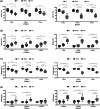Chronological analysis of periodontal bone loss in experimental periodontitis in mice
- PMID: 37997536
- PMCID: PMC10728515
- DOI: 10.1002/cre2.806
Chronological analysis of periodontal bone loss in experimental periodontitis in mice
Abstract
Objectives: Periodontal disease is understood to be a result of dysbiotic interactions between the host and the biofilm, causing a unique reaction for each individual, which in turn characterizes their susceptibility. The objective of this study was to chronologically evaluate periodontal tissue destruction induced by systemic bacterial challenge in known susceptible (BALB/c) and resistant (C57BL/6) mouse lineages.
Material and methods: Animals, 6-8 weeks old, were allocated into three experimental groups: Negative control (C), Gavage with sterile carboxymethyl cellulose 2%-without bacteria (Sham), and Gavage with carboxymethyl cellulose 2% + Porphyromonas gingivalis (Pg-W83). Before infection, all animals received antibiotic treatment (sulfamethoxazole/trimethoprim, 400/80 mg/5 mL) for 7 days, followed by 3 days of rest. Microbial challenge was performed 3 times per week for 1, 2, or 3 weeks. After that, the animals were kept until the completion of 42 days of experiments, when they were euthanized. The alveolar bone microarchitecture was assessed by computed microtomography.
Results: Both C57BL/6 and BALB/c mice exhibited significant bone volume loss and lower trabecular thickness as well as greater bone porosity compared to the (C) and (Sham) groups after 1 week of microbial challenge (p < .001). When comparing only the gavage groups regarding disease implantation, time and lineage, it was possible to observe that within 1 week of induction the disease was more established in BALB/c than in C57BL/6 (p < .05).
Conclusions: Our results reflected that after 1 week of microbial challenge, there was evidence of alveolar bone loss for both lineages, with the loss observed in BALB/c mice being more pronounced.
Keywords: alveolar bone loss; host microbiota interactions; inflammation; periodontal diseases.
© 2023 The Authors. Clinical and Experimental Dental Research published by John Wiley & Sons Ltd.
Conflict of interest statement
The authors declare no conflict of interest.
Figures






Similar articles
-
Long-term evaluation of oral gavage with periodontopathogens or ligature induction of experimental periodontal disease in mice.Clin Oral Investig. 2016 Jul;20(6):1203-16. doi: 10.1007/s00784-015-1607-0. Epub 2015 Sep 28. Clin Oral Investig. 2016. PMID: 26411857
-
Heritability of periodontal bone loss in mice.J Periodontal Res. 2015 Dec;50(6):730-6. doi: 10.1111/jre.12258. Epub 2015 Jan 12. J Periodontal Res. 2015. PMID: 25581386 Free PMC article.
-
CXCR4 signaling contributes to alveolar bone resorption in Porphyromonas gingivalis-induced periodontitis in mice.J Oral Sci. 2017 Dec 27;59(4):571-577. doi: 10.2334/josnusd.16-0830. Epub 2017 Oct 31. J Oral Sci. 2017. PMID: 29093284
-
SOCS-3 Regulates Alveolar Bone Loss in Experimental Periodontitis.J Dent Res. 2016 Aug;95(9):1018-25. doi: 10.1177/0022034516645332. Epub 2016 Apr 28. J Dent Res. 2016. PMID: 27126447 Free PMC article.
-
Experimental periodontitis induced by Porphyromonas gingivalis does not alter the onset or severity of diabetes in mice.J Periodontal Res. 2013 Oct;48(5):582-90. doi: 10.1111/jre.12041. Epub 2013 Jan 14. J Periodontal Res. 2013. PMID: 23317150
Cited by
-
Methylome-wide analysis in systemic microbial-induced experimental periodontal disease in mice with different susceptibility.Front Cell Infect Microbiol. 2024 Jul 16;14:1369226. doi: 10.3389/fcimb.2024.1369226. eCollection 2024. Front Cell Infect Microbiol. 2024. PMID: 39086605 Free PMC article.
-
Insights into periodontal disease: comparative analysis of animal models.Front Dent Med. 2025 Apr 25;6:1560101. doi: 10.3389/fdmed.2025.1560101. eCollection 2025. Front Dent Med. 2025. PMID: 40352291 Free PMC article. Review.
-
M2 Macrophage-Derived Extracellular Vesicles Reprogram Immature Neutrophils into Anxa1hi Neutrophils to Enhance Inflamed Bone Regeneration.Adv Sci (Weinh). 2025 Jul;12(28):e2416159. doi: 10.1002/advs.202416159. Epub 2025 Apr 25. Adv Sci (Weinh). 2025. PMID: 40277454 Free PMC article.
References
-
- Abusleme, L. , Dupuy, A. K. , Dutzan, N. , Silva, N. , Burleson, J. A. , Strausbaugh, L. D. , Gamonal, J. , & Diaz, P. I. (2013). The subgingival microbiome in health and periodontitis and its relationship with community biomass and inflammation. The ISME Journal, 7(5), 1016–1025. 10.1038/ismej.2012.174 - DOI - PMC - PubMed
-
- Baker, P. J. , Dixon, M. , Evans, R. T. , Dufour, L. , Johnson, E. , & Roopenian, D. C. (1999). CD4+ T cells and the proinflammatory cytokines gamma interferon and interleukin‐6 contribute to alveolar bone loss in mice. Infection and Immunity, 67(6), 2804–2809. 10.1128/iai.67.6.2804-2809.1999 - DOI - PMC - PubMed
Publication types
MeSH terms
Substances
Grants and funding
LinkOut - more resources
Full Text Sources

